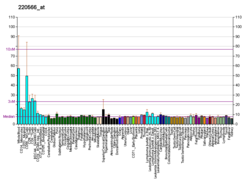| PIK3R5 |
|---|
|
| Identifiers |
|---|
| Aliases | PIK3R5, F730038I15Rik, FOAP-2, P101-PI3K, p101, phosphoinositide-3-kinase regulatory subunit 5 |
|---|
| External IDs | OMIM: 611317; MGI: 2443588; HomoloGene: 8627; GeneCards: PIK3R5; OMA:PIK3R5 - orthologs |
|---|
| Gene location (Human) |
|---|
 | | Chr. | Chromosome 17 (human)[1] |
|---|
| | Band | 17p13.1 | Start | 8,878,911 bp[1] |
|---|
| End | 8,965,712 bp[1] |
|---|
|
| Gene location (Mouse) |
|---|
 | | Chr. | Chromosome 11 (mouse)[2] |
|---|
| | Band | 11|11 B3 | Start | 68,322,947 bp[2] |
|---|
| End | 68,388,675 bp[2] |
|---|
|
| RNA expression pattern |
|---|
| Bgee | | Human | Mouse (ortholog) |
|---|
| Top expressed in | - granulocyte
- blood
- monocyte
- spleen
- bone marrow cells
- upper lobe of left lung
- lymph node
- right lung
- appendix
- gallbladder
|
| | Top expressed in | - granulocyte
- thymus
- blood
- mesenteric lymph nodes
- stroma of bone marrow
- spleen
- outer nuclear layer
- otic vesicle
- subcutaneous adipose tissue
- lumbar subsegment of spinal cord
|
| | More reference expression data |
|
|---|
| BioGPS |  | | More reference expression data |
|
|---|
|
| Gene ontology |
|---|
| Molecular function | - G-protein beta/gamma-subunit complex binding
- phosphatidylinositol-4,5-bisphosphate 3-kinase activity
- 1-phosphatidylinositol-3-kinase regulator activity
| | Cellular component | - cytoplasm
- plasma membrane
- phosphatidylinositol 3-kinase complex, class IB
- membrane
- nucleus
- phosphatidylinositol 3-kinase complex
- microtubule organizing center
- cytosol
| | Biological process | - platelet activation
- positive regulation of protein kinase B signaling
- regulation of phosphatidylinositol 3-kinase activity
- positive regulation of MAP kinase activity
- phosphatidylinositol 3-kinase signaling
- phosphatidylinositol phosphate biosynthetic process
- G protein-coupled receptor signaling pathway
- positive regulation of phosphatidylinositol 3-kinase signaling
- phosphatidylinositol biosynthetic process
| | Sources:Amigo / QuickGO |
|
| Orthologs |
|---|
| Species | Human | Mouse |
|---|
| Entrez | | |
|---|
| Ensembl | | |
|---|
| UniProt | | |
|---|
| RefSeq (mRNA) | NM_001142633
NM_001251851
NM_001251852
NM_001251853
NM_001251855
|
|---|
NM_014308
NM_001388396
NM_001388397
NM_001388398
NM_001388399
NM_001388400 |
| |
|---|
| RefSeq (protein) | NP_001136105
NP_001238780
NP_001238781
NP_001238782
NP_001238784
|
|---|
NP_055123 |
| |
|---|
| Location (UCSC) | Chr 17: 8.88 – 8.97 Mb | Chr 11: 68.32 – 68.39 Mb |
|---|
| PubMed search | [3] | [4] |
|---|
|
| Wikidata |
| View/Edit Human | View/Edit Mouse |
|


















